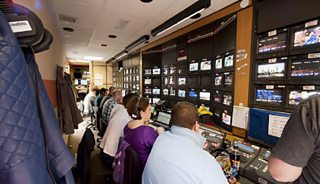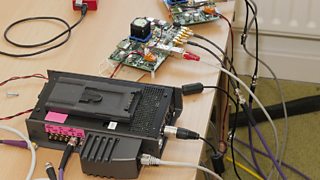Hi, I’m Nick Pinks, and I’m one of the team of people that brought you the ��������’s most comprehensive coverage of Glastonbury ever – with live streams broadcast from 6 key stages, 120 performances live and on demand, and 250 hours of coverage all available whenever and wherever you wanted. Whether that was sneaking a look on the PC in the office, on the bus on your mobile or tablet or via your connected TV from the comfort of your sofa – we brought you closer to the festival action than ever before.
My colleaguesand all blogged before Glastonbury and talked about how we were going to bring you a festival on this scale. But, after an astounding weekend, where even the mud stayed away (mostly) from the fields of Worthy Farm, I wanted to share with you how teams across the �������� came together to deliver the first digital Glastonbury.
The ��������’s Digital Glastonbury hub
During the weekend, we turned the ��������’s R&D in Shepherds Bush into the production hub for the ��������’s Digital Glastonbury 2013, and along with the team on the ground at the festival and colleagues in MediaCity UK in Salford, gave you unprecedented coverage from the festival.

Monitoring output in the Glastonbury Digital Hub
This was the culmination of months of planning and preparation, bringing teams and technologies from across the whole of the �������� together in a way that hasn’t really been tried before and certainly not at this scale for a live music event. In essence we put a whole festival together in our labs with colleagues from Radio & Music Multi-platform, Future Media, News Location Facilities, Broadcast Systems Development, Sport Multi-platform and Music Television (plus volunteers from other teams such as Finance and Marketing).
In order to keep costs down,we turned the whole production process upside down. Instead of sending many of the team to a muddy field in Somerset, we used the latest connectivity to get all the coverage back to a �������� base, and then brought the necessary producers, editors, compliance experts, bloggers and everyone else together in the R&D base in London or in Salford.�� The immediate benefits are pretty obvious - lower travel and accommodation costs and a readymade office and production environment for people to work in, plus the ability to use our own existing networks and systems to move all the content around as it’s checked, edited, transcoded, and loaded up to be watched.�� What maybe isn’t obvious is what sort of a ‘thing’ you make when you invite the whole of the online coverage of the largest greenfield festival in the world into a building that day to day is a technology R&D lab.
Lets take a look
First of all we took over a fair chunk of the car park with an OB (Outside Broadcast) truck which housed the editors for the red button live streaming output for the weekend.

Live bloggers, site editor and picture editor in action in the Glastonbury Digital Hub
Up on the 3rd floor, we had the compliance area, where the live feeds from the Glastonbury stages were monitored for editorial content by staff from across the ��������.�� Compliers had their fingers hovering over a range of buttons that would trigger anything from an on-screen apology to an immediate cut of the video feed, which thankfully was rarely needed.�� The output from this team then went directly up to Salford via a combination of video circuits and new �������� built , to be encoded by the same systems which brought you the Olympics and, that same weekend, were bringing you online streaming of Wimbledon and the Formula 1 action from Silverstone.
��

Stagebox in action
Just around the corner from the compliance area, in what usually serves as the library for R&D, we packed together the social media team that would be live blogging, tweeting and sharing images and information across the ��������’s platforms.�� And, not only were those guys watching the live unedited feeds from all the stages, but they were hearing the compliance guys talking about the performances, getting the backstage chat from the editors, hearing and seeing all the other bloggers social media activity, and, in a really exciting first time deployment, they were seeing real time page visit stats of all the ��������’s online coverage of the festival.�� No one has really done this in the �������� before - fed real time stats for access straight back into an element of the production team - and in a way it was like putting the production team right in the middle of the audience.�� Pretty appropriate for a festival really!
Meanwhile, as all this activity is going on real time, there was also all the offline, catch-up, on-demand production going on too (told you we were busy!).�� Editors would be reviewing each set as it finished and using special ��������-built tech calledto assemble digital packages to go out on the all the different channels. And just remember, they were doing that right next door to where all the real time conversations on social media were going on – via the , and Facebook, along with the team that were complying the streams.�� Never before have editors had such a close understanding of what their audiences need, almost without having to ask.�� The only way we could have given them a better insight was to have plopped them down with their edit kit in the middle of the mosh-pit at the festival.
Another team then uploaded these videos to the , (and selected clips onto YouTube and other syndication) so you could catch up on those Glasto moments you'd missed. And yes – you guessed it - the guys loading up the videos, with all the metadata, were sitting there amongst a crowd of people who have essentially created a tiny satellite Glastonbury right here in sunny Shepherd’s Bush.�� So they know exactly what the demand is, exactly what the key words that people will be using to search for it will be.
How long did this all take? Well normally you would expect the upload to be an overnight job. However thanks to the massively improved workflow and months of planning, pretty much everything was done and dusted by 3am each morning, a huge improvement in performance. And, due to the project's collaborative nature and the way the technology was tested and deployed, we delivered the most immersive, responsive and electrifying digital festival ever.
Your feedback
The feedback so far has been fantastic. We saw huge numbers of you tuning in to the ��������’s Glastonbury coverage online and via the red button with a record 1.5 million unique browsers to the ��������’s Glastonbury content throughout the weekend. You seemed to love watching it on the go, with 42 per cent of total traffic across the weekend from mobiles and tablets. Over 6.2m of you pressed red over the weekend, up by 77 per cent compared Glastonbury 2011. And no surprise, the legendary Rolling Stones performance on Saturday night was the most watched with over 700,000 requests (and growing).
We like to hear how we can improve our coverage again for next year, so please leave a comment below. I’m already looking forward to Glastonbury 2014 and thinking about how the �������� can improve its digital coverage.
is a Technology Transfer Manager in �������� R&D
